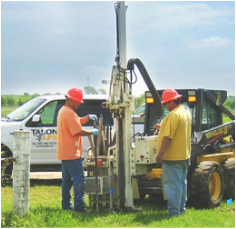At some point you may be faced with the need to investigate a parcel of land. For example, a common reason people are faced with an investigation is when buying/selling land. Most state laws require sellers to disclose environmental conditions to prospective buyers. Before they purchase, buyers can avoid liability for existing environmental conditions by doing a minimal level of “due diligence” to find out about environmental conditions. The most direct way to show that a property is free of contamination is to run chemical analyses on soil. First, however, you must collect the soil samples.
Why would soil samples be collected from my land?
Soil samples are typically collected from specific depths below the ground surface which usually requires use of drilling equipment. Borings are drilled to specific depths and special sampling tools are used to collect soil samples. The sampling tools are brought up to the surface where samples are taken and placed in appropriate containers for testing at an analytical laboratory. Soil samples provide data about potential contamination in surface soil (0 to 3 feet) that may affect animals and people in residences, and in subsurface soil (3 to 15 feet) that may affect utility, construction or excavation workers.
Which drilling method is best?
Choosing the best drilling method depends on several factors including soil composition, type of samples and depth to groundwater. Direct push and hollow stem auger are the two most common drilling methods for soil sampling and should be suitable for most site conditions. For difficult conditions like caliche layers, cementitious rock, or igneous rock, other drilling methods should be considered.
Should you choose Direct Push or Hollow Stem Auger Drilling?
Direct push drilling is best in sandy, silty or clayey (but not rocky) soil with a depth range of about 30 feet. Hydraulic force pushes the drilling pipe into the ground and creates a cylinder of soil that moves up during drilling into a clear acetate liner set within the macro core sampler. When the drill pipe is removed from the borehole, the acetate liner filled with soil is removed from the macro core sampler. The soil is accessed by cutting the acetate liner open and samples can be obtained from anywhere on that length of soil core.
Hollow stem auger drilling is effective in mixed, gravelly or harder soil with a depth range of about 50 to 150 feet. Flights of hollow auger pipe with drilling teeth at the leading end are rotated by pressure, or “augured” into the ground. At the desired depth a central plug is removed and the desired sampling apparatus is placed in the borehole typically a split spoon sampler. Auger drilling allows more sampling flexibility, including disturbed (standard penetrometer) or undisturbed (Shelby tube) sample methods.
Who Offers Both Direct Bush and Hollow Stem Auger Drilling?
Talon/LPE has more than 50 years combined experience providing drilling services to a diverse clientele throughout Texas, Oklahoma, New Mexico and Kansas. We are experts in our industry and have used Direct Push and Hollow Stem Auger drilling methods for countless projects. Most importantly, safety is our top concern. Our firm specializes in environmental drilling. Contact us today for more information about our environmental drilling services.

